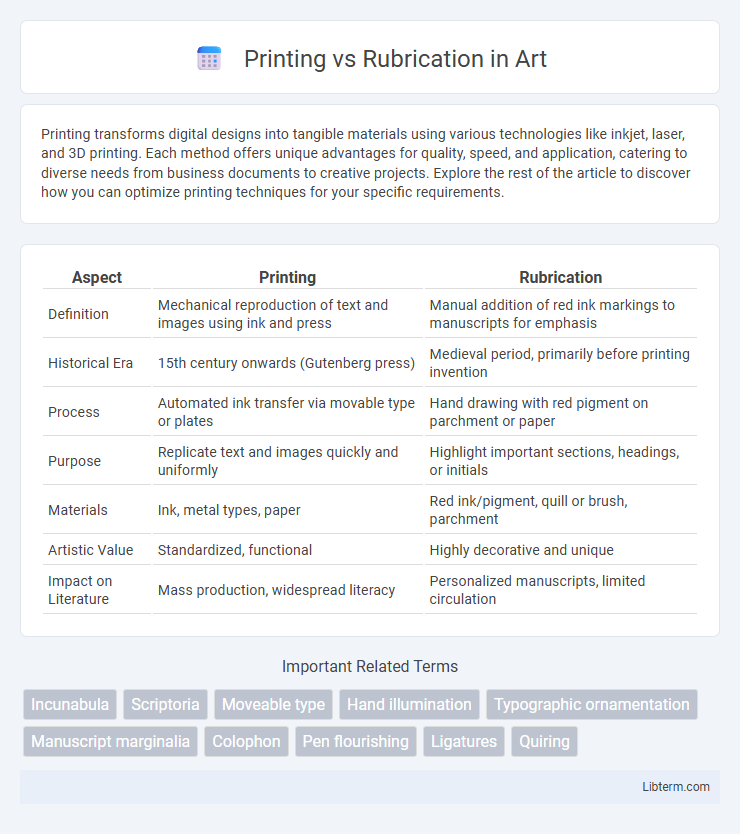Printing transforms digital designs into tangible materials using various technologies like inkjet, laser, and 3D printing. Each method offers unique advantages for quality, speed, and application, catering to diverse needs from business documents to creative projects. Explore the rest of the article to discover how you can optimize printing techniques for your specific requirements.
Table of Comparison
| Aspect | Printing | Rubrication |
|---|---|---|
| Definition | Mechanical reproduction of text and images using ink and press | Manual addition of red ink markings to manuscripts for emphasis |
| Historical Era | 15th century onwards (Gutenberg press) | Medieval period, primarily before printing invention |
| Process | Automated ink transfer via movable type or plates | Hand drawing with red pigment on parchment or paper |
| Purpose | Replicate text and images quickly and uniformly | Highlight important sections, headings, or initials |
| Materials | Ink, metal types, paper | Red ink/pigment, quill or brush, parchment |
| Artistic Value | Standardized, functional | Highly decorative and unique |
| Impact on Literature | Mass production, widespread literacy | Personalized manuscripts, limited circulation |
Introduction to Printing and Rubrication
Printing revolutionized information dissemination by enabling mass reproduction of texts using movable type, significantly increasing accessibility and reducing manual labor. Rubrication, an ancient manuscript tradition, involved the manual addition of red ink headings and annotations to highlight key sections and enhance readability. While printing automated the process of text replication, rubrication preserved the decorative and organizational role through handcrafted embellishments.
Historical Context: Origins and Development
Rubrication emerged during the medieval manuscript era, characterized by hand-applied red ink to emphasize titles, initials, and important text elements, serving both decorative and functional purposes in illuminated texts. The advent of the printing press in the 15th century marked a significant shift, as movable type enabled mass production of texts, though early printed books often retained rubrication techniques through hand embellishments to mimic manuscript aesthetics. Over time, printing technology evolved, reducing reliance on rubrication while shaping the standardization of text presentation in the Renaissance and beyond.
Defining Printing and Rubrication
Printing involves the mechanical reproduction of text and images, typically using movable type or digital presses to produce multiple copies efficiently. Rubrication refers to the manual addition of red or colored ink to manuscripts, traditionally used to highlight headings, initial letters, or important sections in medieval texts. While printing revolutionized mass dissemination of information, rubrication preserved visual hierarchy and emphasis in hand-crafted documents.
Techniques and Processes Compared
Printing employs mechanical or digital methods like lithography, offset, or inkjet to reproduce text and images rapidly on paper, relying on plates or digital files for consistent output. Rubrication involves manual application of red ink using quills or brushes to highlight specific sections in manuscripts, demanding precision and labor-intensive craftsmanship. While printing ensures uniformity and mass production, rubrication emphasizes decorative embellishment and personalized detailing in historical documents.
Materials and Tools Used
Printing primarily relies on materials such as ink, paper, and a variety of printing presses including letterpress, offset, and digital printers. Rubrication involves the use of red ink or pigment, typically applied with quills or brushes on parchment or vellum to highlight sections of handwritten manuscripts. While printing allows mass reproduction with modern machinery, rubrication depends on manual artistry using traditional tools for personalized embellishment.
Visual Impact and Aesthetics
Printing offers consistent clarity and precision in typography, allowing for uniform text and images that enhance readability and professional appearance in books and documents. Rubrication, the hand-applied addition of red ink or colored highlights, introduces a striking visual contrast that guides the reader's eye and emphasizes important sections, lending a unique, handcrafted aesthetic. The tactile texture and irregularities of rubrication create a sense of historical authenticity and artistic value that printing alone cannot replicate.
Role in Book Production and Manuscripting
Printing revolutionized book production by enabling mass duplication of text with uniformity and speed through movable type, vastly reducing manual labor compared to rubrication. Rubrication, an early manuscript embellishment technique, involved hand-applied red ink to highlight headings and important sections, enhancing readability and organization in medieval texts. While printing standardized text replication, rubrication played a critical role in the aesthetic and functional aspects of manuscript design before the advent of mechanical reproduction.
Cost and Labor Considerations
Printing significantly reduces labor costs compared to rubrication, as automated presses enable mass production with minimal manual effort. Rubrication involves meticulous handwork to apply red ink for emphasis, increasing both time and labor expenses. Consequently, printing offers a more cost-effective solution for large-scale book production, while rubrication remains suitable for limited, high-value manuscripts requiring artisanal detailing.
Cultural and Educational Significance
Printing revolutionized cultural and educational accessibility by enabling mass production of texts, standardizing information and promoting widespread literacy. Rubrication, an early manuscript technique using red ink to highlight important sections, enhanced comprehension and guided readers through complex texts in medieval educational contexts. The transition from rubrication to printing marked a pivotal shift in knowledge dissemination, democratizing learning and preserving diverse cultural heritages more efficiently.
Modern Relevance and Preservation
Printing remains essential for mass production and digital integration, enabling widespread distribution and accessibility of texts in various formats, unlike rubrication, which is limited to decorative manuscript embellishments. Modern relevance of rubrication lies in historical preservation and scholarly study, as it provides insight into medieval craftsmanship and textual emphasis, enriching cultural heritage. Preservation efforts prioritize digitizing printed materials for durability and accessibility while maintaining rubricated manuscripts as vital artifacts reflecting artistic and textual history.
Printing Infographic

 libterm.com
libterm.com